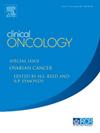Weathering the Storm: The Impact of Weather Events, Lockdowns and Holidays on Oncology and General Emergency Presentations to a United Kingdom Tertiary Centre-A 7.5-year Review
IF 3
3区 医学
Q2 ONCOLOGY
引用次数: 0
Abstract
Aims
Weather extremes, public holidays and weekend effects modulate emergency department activity. Their impact on oncology-specific emergency presentations remains poorly defined. The aim of this study was to determine how COVID-19 lockdowns, weather extremes, and calendar factors influence oncology emergency presentations versus all-cause emergency presentations at a United Kingdom tertiary academic centre.
Materials and Methods
We conducted a 7.5-year retrospective time-series analysis of daily oncology-specific and all-cause emergency presentations (1/01/2017-9/7/2024). A quasi‑Poisson distributed lag non-linear model quantified same-day and cumulative (0-21 day) effects of COVID-19 lockdowns, weather extremes (≤2.5th or ≥97.5th percentile), public holidays, and day of the week, on daily presentation rates.
Results
Of 970,884 emergencies, 27,946 (2.9%) were oncology-specific. Lockdowns reduced oncology emergencies by 11% (cumulative relative risk [RR] = 0.89; 95% CI: 0.80-0.99, P = 0.034) and all-cause attendances by 6% (cumulative RR = 0.94; 95% CI: 0.92-0.97, P < 0.0001). Both rebounded after lockdown. Oncology presentations showed no significant association with extreme cold/heat, heavy rainfall or snow, whereas all-cause attendances rose 6% in very-cold weather (cumulative RR= 1.06; 95% CI: 1.03-1.10, P = 0.0009) and fell 7% in heavy rain (cumulative RR = 0.93; 95% CI: 0.89-0.98, P = 0.002). Public holidays halved oncology emergencies (cumulative RR = 0.49; 95% CI: 0.44-0.55, P < 0.001) versus a 9% fall in all-cause emergencies (cumulative RR = 0.91; 95% CI: 0.90-0.93; P < 0.0001). The Boxing Day to New Year period increased oncology emergencies by 21% (same day RR = 1.21; 95% CI: 1.09-1.33, P = 0.0002) and all-cause by 4% (cumulative RR = 1.04; 95% CI: 1.02-1.06, P = 0.001). Weekend volumes for oncology emergencies fell 58% (cumulative RR = 0.42; 95% CI: 0.39-0.45, P < 0.0001), compared with a 15% decrease in all-cause emergencies (same day RR = 0.85; 95% CI: 0.84-0.86, P < 0.0001).
Conclusion
Oncology emergency demand was significantly influenced by calendar constraints (public holidays, weekends, lockdowns) but not by weather extremes. All-cause emergencies were influenced by both calendar and weather extremes. Calendar-based rostering of oncology staff around holiday periods and weekends may therefore yield greater benefit than weather-triggered surge plans. Validation in centres with wetter or more extreme climates is warranted.
风化风暴:天气事件、封锁和假期对肿瘤学和一般急诊的影响——英国高等教育中心7.5年回顾
极端天气、公众假期和周末的影响会调节急诊科的活动。它们对肿瘤特异性急诊表现的影响仍不明确。本研究的目的是确定COVID-19封锁、极端天气和日历因素如何影响英国高等教育学术中心的肿瘤急诊报告与全因急诊报告。材料与方法我们对每日肿瘤特异性和全因急诊病例(2017年1月1日- 2024年9月7日)进行了为期7.5年的回顾性时间序列分析。准泊松分布滞后非线性模型量化了COVID-19封锁、极端天气(≤2.5或≥97.5%)、公共假日和一周中的哪一天对每日报告率的当日和累积(0-21天)影响。结果970,884例急诊中,肿瘤特异性27,946例(2.9%)。封锁使肿瘤急诊减少11%(累积相对风险[RR] = 0.89;95% CI: 0.80-0.99, P = 0.034),全因出勤率降低6%(累积RR = 0.94;95% CI: 0.92-0.97, P <;0.0001)。封锁后两者都反弹了肿瘤学报告显示与极冷/高温、强降雨或降雪没有显著关联,而在极冷天气下,全因出席率上升了6%(累积RR= 1.06;95% CI: 1.03-1.10, P = 0.0009),暴雨时下降7%(累积RR = 0.93;95% ci: 0.89-0.98, p = 0.002)。公共假期使肿瘤急诊减半(累积RR = 0.49;95% CI: 0.44-0.55, P <;0.001),而全因紧急情况下降了9%(累积RR = 0.91;95% ci: 0.90-0.93;P & lt;0.0001)。节礼日至新年期间肿瘤急诊增加21%(当日RR = 1.21;95% CI: 1.09-1.33, P = 0.0002),全因死亡率为4%(累积RR = 1.04;95% ci: 1.02-1.06, p = 0.001)。周末肿瘤急诊数量下降58%(累积RR = 0.42;95% CI: 0.39-0.45, P <;0.0001),而全因紧急情况减少了15%(当日RR = 0.85;95% CI: 0.84-0.86, P <;0.0001)。结论肿瘤急诊需求受时间限制(公共假期、周末、封锁)的影响显著,但不受极端天气的影响。所有原因的紧急情况都受到日历和极端天气的影响。因此,根据日历在假日和周末前后对肿瘤工作人员进行排班,可能比天气引发的激增计划产生更大的好处。有必要在气候更潮湿或更极端的中心进行验证。
本文章由计算机程序翻译,如有差异,请以英文原文为准。
求助全文
约1分钟内获得全文
求助全文
来源期刊

Clinical oncology
医学-肿瘤学
CiteScore
5.20
自引率
8.80%
发文量
332
审稿时长
40 days
期刊介绍:
Clinical Oncology is an International cancer journal covering all aspects of the clinical management of cancer patients, reflecting a multidisciplinary approach to therapy. Papers, editorials and reviews are published on all types of malignant disease embracing, pathology, diagnosis and treatment, including radiotherapy, chemotherapy, surgery, combined modality treatment and palliative care. Research and review papers covering epidemiology, radiobiology, radiation physics, tumour biology, and immunology are also published, together with letters to the editor, case reports and book reviews.
 求助内容:
求助内容: 应助结果提醒方式:
应助结果提醒方式:


